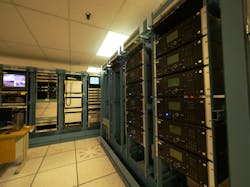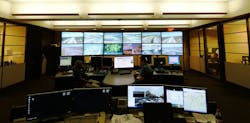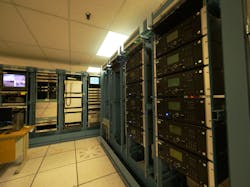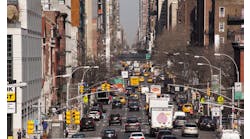By: Tim Bruns
A safe and efficient transportation system is an invaluable asset to any city.
This statement comes directly out of the Intelligent Transportation Systems (ITS) plan for the city of Dallas. The city’s transportation leaders and partners are attempting to foster the concept of a safe and efficient transportation network by enhancing the way their traffic management system operates.
In partnership with Ericsson, a leading provider of information and communications technology, the Dallas Department of Transportation (DDOT) is upgrading its traffic system in a way that will improve emergency response times, signal timing, and signal priority for transit or emergency vehicles. In addition to this, the upgrades will push the city in the direction of preparing for automated and connected vehicles, as well as giving the Dallas area transportation system the ability to adopt other future technologies.
“We are trying to become a city that makes decisions based on data,” Michael Rogers, director of DDOT, told Roads & Bridges. “When we initially did this, we looked at our whole traffic management system—we weren’t necessarily just looking at it from a traffic standpoint. We can make a difference within our traffic patterns and response times, but then we will also have the foundation to support public transportation, public safety, and things that we don’t even know at this particular point because we just haven’t thought about it yet.”
The camera system component used in Dallas traffic management centers allows traffic control staff to spot areas with traffic backups.
Growing a backbone
According to Ericsson’s case study on its work with the Dallas-Fort Worth area, four cities in the metropolitan region (Dallas, Fort Worth, Irving and Richardson) have launched a smart traffic system that employs the company’s Connected Urban Transport ITS platform. This platform is designed to help the cities in this region apply real-time data from traffic sensors and cameras to automate and control traffic signals and message signs in order to improve traffic flow and operational responses.
Being connected to the same centralized traffic management software allows the cities to share status and information data between agencies from each of the connected cities. This, in turn, enables the agencies within different cities from across the region to coordinate traffic plans that go across agency or city boundaries, coordinate multi-agency responses to incidents, and provide real-time analysis of regional performance measures.
“It’s all about transforming data into real-time action and intelligent insight across silos within a city and across silos between the cities, securely,” Dr. Brenda Connor, head of smart cities and intelligent transport systems at Ericsson, told Roads & Bridges.
For the city of Dallas, the Connected Urban Transport ITS platform has become the backbone for the city to manage its traffic systems more effectively and efficiently with goals that include reducing congestion, increasing safety and improving the public transportation system. The city is rolling out the platform in phases. So far, the system has made significant upgrades to Dallas’ traffic controllers within the city. In the first phase of system upgrades, 600 signalized intersections were integrated into the system within the first 60 days of contract go-ahead.
“Right now, the majority of our traffic controllers have the upgraded system,” Rogers said. “So if there’s any type of communications issues or anything that’s happening, we know immediately of these particular issues.” Some of the ways the intersections and traffic controllers have been improved is that the city can retime its traffic signals remotely without sending out a worker to that particular site. Additionally, as soon as all cameras are put in place and the video component is integrated into the system, the city’s traffic management centers will be able to identify where traffic backups are occurring and respond accordingly.
Better signals and responses
One of the ways in which the Ericsson ITS platform is improving the Dallas traffic system is with better signal timing with smarter traffic signals. “We deployed the ability for [the city] to centrally see, manage and control the traffic controllers that are out there in its 1,500 signalized intersections,” Connor said. These traffic controllers at the intersections are connected to the Dallas traffic operations center, which routes securely up to Ericsson’s cloud, which hosts the ITS traffic management platform. These traffic controllers, combined with the video management system that Ericsson is in the process of deploying, put tools in the hands of traffic operations center staff to adjust signal timing drifts right from the traffic management center.
Another improved traffic element from these system upgrades, particularly in regards to safety, is the ability for traffic controllers to more quickly respond to traffic crashes or accidents. “By having information like this very quickly, we can then get our public safety vehicles out there as quickly as possible,” Rogers said. “We don’t necessarily have to wait for phone calls to come in. We’ve got to get out there and try to get those incidents responded to as quickly as possible because nine out of 10 times you can have secondary incidents that occur.”
By implementing personalized insight, a feature from the Ericsson ITS software, traffic control center staff have the ability to see traffic volume counts in all directions at an intersection where the traffic system has been updated. If the traffic sensors detect that the traffic volume goes below an expected level, the system generates a trigger to alert traffic management personnel of the traffic backup. If the traffic operator determines that an incident may have occurred near a particular intersection, they can send a notification to the local 9-1-1 call center regarding the traffic disruption. With the video management system, traffic operators also can send the 9-1-1 centers a link to the camera footage at that particular intersection. This feature allows traffic control staff to dispatch the necessary emergency services to respond to any particular traffic incident, without relying on a bystander reporting the incident.
The traffic upgrades in Dallas also benefit the Dallas Area Rapid Transit (DART) bus system schedule. The traffic sensors installed at the intersections have the capability of connecting to a device in a transit vehicle that would trigger the light to provide signal priority to the bus. This capability, in the long term, will enable the city’s plans for a bus rapid transit system to be implemented.
“It’s the backbone for enhancing our public transit systems, where we don’t necessarily have a full bus rapid transit system, but can start working on areas where the buses can start to do queue jumping where we have that signal priority in those locations,” Rogers said. “And so what we’re trying to do is create a network that allows the transit to be able to have that priority, but then as soon as they get through the intersection, not necessarily be backed up once again.”
The Connected Urban Transport ITS platform has become the backbone for Dallas to manage its traffic systems more effectively.
Future benefits
DDOT is looking at a number of other ways in which the ITS platform can help to transform the city’s traffic system in the future. These include improvements to the traffic sensor network, which can be implemented for the purpose of targeting vehicles, pedestrians or cyclists. Another objective for the city of Dallas is to reduce environmental impacts from city congestion by reducing traffic backups and vehicle idling times, as the upgraded system aims to keep motorists moving across the city and surrounding areas.
Part of the next phase for DDOT is to integrate the ITS technology into the city’s major road projects. “What we’re trying to do is make sure we’re coordinating some of these smart cities principals in these projects,” Rogers said. “It’s very important for us to look at ways in which we can start to leverage those funded projects to bring in the infrastructure that’s necessary to benefit our community.” Some of those smart technology improvements the city is looking to incorporate into future projects include smart street lighting and providing broadband Internet to Dallas communities.
The ITS platform functioning as the traffic system and communication backbone for Dallas is crucial as the next step for the city to move in the direction of preparing for connected and autonomous vehicles. As such, the city of Dallas remains open to adopting and implementing new technologies across their transportation network. “I think by having that backbone in an area that can accept potential technology puts us in a very good position,” Rogers said. “So as we grow and as the city evolves, we want to welcome technology because if there’s a better way to do things, I think the city at least wants to be engaged with the technology companies to help us understand what we’ve got and how to manage things as efficiently as possible.”
About The Author: Bruns is associate editor of Roads & Bridges.





